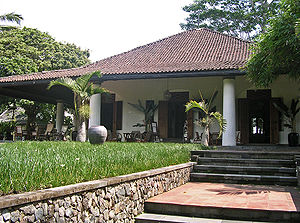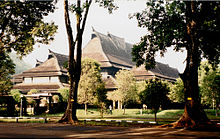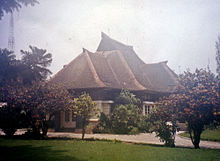- Colonial architecture of Indonesia
-
Dutch colonial architecture in Indonesia was predominantly built in Java, however, buildings from the Dutch East Indies era were built across the archipelago.
Contents
Early architecture: replicating the mother country
The 16th and 17th centuries saw the arrival of European powers in Indonesia who used masonry for much of their construction. Previously timber and its by-products had been almost exclusively used in Indonesia, with the exception of some major religious and palace architecture. One of the first major Dutch settlements was Batavia (later Jakarta) which in the 17th and 18th centuries was a fortified brick and masonry city.[1]
For almost two centuries, the colonialists did little to adapt their European architectural habits to the tropical climate.[2] In Batavia, for example, they constructed canals through its low-lying terrain, which were fronted by small-windowed and poorly ventilated row houses, mostly in a Chinese-Dutch hybrid style. The canals became dumping grounds for noxious waste and sewage and an ideal breeding ground for the anopheles mosquitos, with malaria and dysentery becoming rife throughout the Dutch East Indies colonial capital.[2]
Adaptation to the local environment
Although row houses, canals and enclosed solid walls were first thought as protection against tropical diseases coming from tropical air, years later the Dutch learnt to adapt their architectural style with local building features (long eaves, verandahs, porticos, large windows and ventilation openings).[3] The Indo-European hybrid villa of the 19th century were among the first colonial buildings to incorporate Indonesian architectural elements and attempt adapting to the climate. The basic form, such as the longitudinal organisation of spaces and use of joglo and limasan roof structures, was Javanese, but it incorporated European decorative elements such as neo-classical columns around deep verandahs.[4]
Whereas the Indo-European homes were essentially Indonesian houses with European trim, by the early 20th century, the trend was for modernist influences—such as art-deco—being expressed in essentially European buildings with Indonesian trim (such as the pictured home's high-pitched roofs with Javan ridge details). Practical measures carried over from the earlier Indo-European hybrids, which responded to the Indonesian climate, included overhanging eaves, larger windows and ventilation in the walls.[5]
20th century modernisms
At the end of the 19th century, great changes were happening across much of colonial Indonesia, particularly Java. Significant improvements to technology, communications and transportation had brought new wealth to Java's cities and private enterprise was reaching the countryside.[6] Modernistic buildings required for such development appeared in great numbers, and were heavily influenced by international styles. These new buildings included train stations, business hotels, factories and office blocks, hospitals and education institutions. The largest stock of colonial era buildings are in the large cities of Java, such as Bandung, Jakarta, Semarang, and Surabaya. Bandung is of particular note with one of the largest remaining collections of 1920s Art-Deco buildings in the world, with the notable work of several Dutch architects and planners, including Albert Aalbers, Thomas Karsten, Henri Maclaine Pont, J Gerber and C.P.W. Schoemaker.[7]
In the first three decades of the twentieth century, the Public Works Department rolled out major public building and city planning programs. The key designer was Karsten who developed his predecessors' ideas for incorporating indigenous Indonesian elements into rational European forms. His first commission upon arrival in the Indies was the New Candi suburb of Semarang on the north coast of Central Java. He led the urban expansion and rebuilding of 12 of the 19 municipalities in Java and 3 out of 9 in Sumatra.[8]
The outer islands
Colonial rule was never as extensive on the island of Bali as it was on Java— it was only in 1906, for example, that the Dutch gained full control of the island—and consequently the island only has a limited stock of colonial architecture. Singaraja, the island's former colonial capital and port, has a number of art-deco kantor style homes, tree-lined streets and dilapidated warehouses. The hill town of Munduk, a town amongst plantations established by the Dutch, is Bali's only other significant group of colonial architecture; a number of mini mansions in the Balinese-Dutch style still survive.[9]
There are numerous forts built by European powers across the archipelago, but particularly in the Maluku Islands, during the early colonial era to protect their share of the spice trade. Ambon City was once renowned for its "colonial charm" and stock of Dutch buildings, however, the city was largely destroyed during World War II and rebuilt.q
In independent Indonesia
The lack of development due to the Great Depression, the turmoil of the Second World War and Indonesia's independence struggle of the 1940s, and economic stagnation during the politically turbulent 1950s and 60s, meant that much colonial architecture has been preserved through to recent decades.[10] Although colonial homes were almost always the preserve of the wealthy Dutch, Indonesian and Chinese elites, and colonial buildings in general are unavoidably linked with the human suffering of colonialism, the styles were often rich and creative combinations of two cultures, so much so that the homes remain sought after into 21st century.[4] Native architecture was arguably more influenced by the new European ideas than colonial architecture was influenced by Indonesian styles; and these Western elements continue to be a dominant influence on Indonesia's built environment today.
References
- ^ Schoppert (1997), pp. 38-39
- ^ a b Dawson, B., Gillow, J., The Traditional Architecture of Indonesia, p. 8, 1994 Thames and Hudson Ltd, London, ISBN 0-500-34132-X
- ^ W. Wangsadinata and T.K. Djajasudarma (1995). "Architectural Design Consideration for Modern Buildings in Indonesia". INDOBEX Conf. on Building Construction Technology for the Future: Construction Technology for Highrises & Intelligence Buildings. Jakarta. http://www.wiratman.co.id/ximages/architecture.pdf. Retrieved 2007-01-18.
- ^ a b Schoppert (1997), pp. 72-77
- ^ Schoppert (1997), pp. 104-105
- ^ Schoppert (1997), pp. 102-103
- ^ Schoppert (1997), pp. 102-105
- ^ Vickers (2005), pp 23-25
- ^ Wijaya, M. (2002). Architecture of Bali. Singapore: Archipelago Press & Wijaya Words Ltd. pp. 201 & 202. ISBN 981-4068-25-X.
- ^ Schoppert (1997), p. 105
See also
- Architecture of Indonesia
- List of colonial buildings and structures in Jakarta
Architecture of Indonesia Religious architecture Ancient monuments of Java • Candi • Dieng temples • Borobudur • Prambanan • Candi Sukuh • Balinese temples • Javanese mosque architectureRumah adat
(the traditional vernacular)Balinese • Enggano • Gayonese • Javanese • Minangkabau • Aceh • Nias • Batak • Toraja • Banjar • Sasak • Mentawai • Dayak • Sumba • PapuanPalaces Dutch colonial Post independence & contemporary architecture Post independence architecture in Indonesia • Jengki style • Resort and villa architecture in IndonesiaCategory Categories:- Dutch East Indies
- Indonesian architecture
- Colonial architecture
Wikimedia Foundation. 2010.



